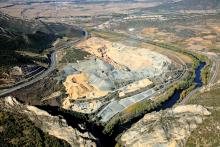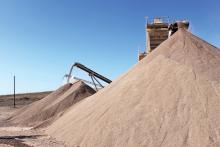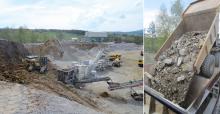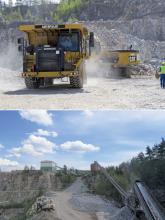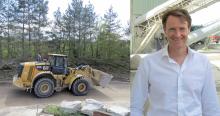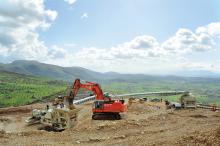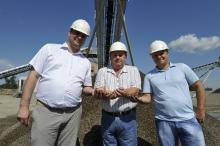
Morocco is in the top ten economies in Africa and its growth plans means it needs construction materials. As with many other countries on the continent it is at present unable to fully meet an insatiable demand for cement and aggregates.
Major port and highway projects are being undertaken, and some of these are being supplied with high quality materials from a comparatively small quarry at Oued Cherrat.
As competition intensifies in the cement sector in Morocco existing companies are getting set for a phase of capacity development.
Demand for cement cooled in 2012 following double-digit growth the year before, but the outlook is positive, and Moroccan companies are now planning new facilities in a bid to maintain market share.
Göran Hjerpe,
“There is a lot of activity in Morocco, Tunisia, Algeria and Libya, and this will be very big.
“A lot of cement is required and a lot of cement is imported. These countries would like to be as independent as possible.
“They have got the conditions for increased cement production because they have got limestone and in many areas they have got clay to make cement but the only thing they lack is iron powder to mix with it.”
Hjerpe, who first sat on his contractor father’s Caterpillar machine when he was two years old and who has worked for the company for over 30 years, was schedule to retire in July.
The area known as Oued Cherrat (Oued means river) is a few hundred metres from the sandy shores of the North Atlantic Ocean and the quarry sits among a cluster of seven other quarries.
Driving along the impressive coastal road, it is 35km north-east of bustling Casablanca, Morocco’s biggest city and commercial centre, and 25km from the capital Rabat.
Casablanca has its Rick’s Café, the mythical saloon from the 1942 Humphrey Bogart film Casablanca, but it is a more recent addition as indeed is the Oued Cherrat quarry.
Access to the Générale des mines et carriers (GMC) quarry is gained by a recently upgraded road, partly paid for by GMC, the quarry management company that operates the site. Speed bumps reduce truck speed as the route is also used by those living along the road, including schoolchildren.
Just off the highway between Casablanca and Rabat is the state-of-the-art, and also recently upgraded and expanded, complex of Tractafric, the Caterpillar dealer that has supplied GMC with much of its equipment.
Indeed, the GMC fleet of Caterpillar hydraulic excavators includes four 345s; one 340D L; two 336s and two 320s along with two Caterpillar 966 wheeled loaders and six Caterpillar 950 wheeled loaders.
These operate at a number of operations throughout Morocco looked after by GMC. Other equipment includes two
Mohamed Esqalli, GMC’s director general is joined by Hjerpe and other Caterpillar global construction and infrastructure representatives Laurent Sarignac, sales manager and Steven Faucher, product application specialist, to tour the site, something they have done many times before.
Esqalli worked for Italian cement producer
“The Générale des mines et carrières” is a company with limited liability created in 2008,” he says.
“Its main activity is quarry management. GMC has important human, machinery and financial assets that allowed it to win the trust of important customers.
“Its activity has rapidly increased since its creation.
“The company has been running the Oued Cherrat aggregate quarry since 2009, and it has a capacity of 1.5 million tonnes of aggregate per year.”
Since 2010, GMC has also had a licence to extract limestone for the cement plant of Ciments de L’Atlas (Group CIMAT) at Ben Ahmed. Ciments de L’Atlas entered the Moroccan cement sector in 2010 establishing a 3.2 million tonnes/year capacity at Ben Ahmed and Beni Mellal. It is also planning to build a third cement plant near Nador, north Morocco in a strategy to maintain a 14% share of the Moroccan market.
These moves are said to have changed the competitive landscape, which was previously dominated by
Annual production at Ben Ahmed is 2 million tonnes/year.
“In addition, GMC is taking care of all the material handling of raw products and finished products of the Ben Ahmed cement plant,” says Esqalli.
It is one of many quarries being managed by GMC throughout Morocco.
“Since January 2013, GMC has also handled the quarry of Agni, southern Morocco, which belongs to the EMT company. The quarry feeds all the needs of rocks (embankments) and aggregates for the nearby Sidi Ifni port project.
“GMC has also recently been granted the tender for the running of the Temara cement plant, near Rabat. The annual production is planned to be 700,000 tonnes.
“It is quite big business to manage a quarry, and the cement industry is a big industry in Morocco.”
To handle these contracts, GMC’s fleet comprises exclusively new equipment, and is growing monthly to adapt to the rapid growth of GMC’s activities. Its first piece of Caterpillar equipment, a 345 hydraulic excavator, was bought from Tractafric Equipment in January 2010.
The Oued Cherrat quarry, which employs 65 people, produces aggregates for use in road, rail and port construction, and its main customers are civil works companies.
“We provided materials from this quarry for the Casablanca-Rabat motorway improvements and also for the motorway around Rabat as well as for the high-speed railway project between Casablanca and Tangier,” says Esqalli.
The under-construction railway line will be 350km long and will be the first high-speed rail line in Africa when completed in 2015.
Another major project is the new North African highway, which will run 5,600km from Morocco to Egypt when it is completed.
At Oued Cherrat, a region noted for its agriculture, the main industry in Morocco, and for wine, GMC quarries some 350tonnes of limestone an hour to feed the static crushers.
“The limestone here is very good. We drill and blast and load and transport material to the crushers where we crush and supply the customers,” says Esqalli.
Drilling and blasting, using either Atlas Copco T35 or Fukurawa HCR1200 drills, is carried out most days (except Sundays) and at least four times a week. Each blasting session uses 2.5tonnes of explosives and produces 10,000tonnes of rock.
“We are allowed to blast a maximum of 2.5tonnes but we are looking to increase this to four tonnes. Most of the blasted materials go to the crushers but we have a customer that we provide with rocks and raw materials. This is for port works in Casablanca,” says Esqalli.
“We load the blasted materials on trucks using a Caterpillar 345 excavator and the trucks unload into a hopper at the start of the crushing operation.”
The crushing operation was started in 2009, and the primary crusher is a
Material loaded into the hopper is 800mm medium limestone and goes either to a Metso VF561-2V primary feeder or the C125 crusher where it is fed to a CVB2060 screen. Secondary crushing uses the Nordberg (Metso) NP1315 impact crusher with material screened using a TS3.3 screen.
“After the primary crushing sometimes we can eliminate the fines, depending on the raw material. Sometimes the material can go to the stockpile. After the stockpile we go to the secondary crusher and after this to the two screens where we can produce sand, aggregate for concrete and aggregate for road construction. We can produce what we want.
“For concrete we produce sand along with 0-4mm, 4-6mm, 6-8mm and 8-15mm aggregates. Other sizes include 0-25mm, 0-30mm, 32-80mm and 25-320mm.”
Reserves at Oued Cherrat are estimated at 10 million m³ or 15 years, and the site required a licence to operate as well as an environmental study provided by the government, and a public inquiry.
“Before the inquiry all the people living around the proposed project are asked if they agree or not with the project,” says Esqalli.
“Before you are allowed to start a quarry all the technical requirements are needed. You present the project with the technical exploration and how you will manage the quarry and at the end of the quarry life what kind of restoration you will make.”
Drilling
2 x Atlas Copco T35
2 x Furukawa drilling
Hydraulic Excavators
4 x Caterpillar 345DL
1 x Caterpillar 340DL
2 x Caterpillar 336DL
2 x Caterpillar 320DL
Hauling
17 x 8x4 trucks (mainly Scania and Mercedes)
Wheeled Loaders
2 x Caterpillar 966H
6 x Caterpillar 950H
Crushing (Oued Cherrat)
1 x Metso C125 primary
jaw crusher
1 x Metso NP1315 impact crusher
Screening (Oued Cherrat)
1 x Metso CVB2060 screen
1 x Metso TS3.3 screenAnother important feature of running the quarry is the regular visits and assessments carried out by Caterpillar to make sure everything is operating efficiently.
“At the on-site assessment we look at the quarry and offer a variety of advice on such issues as safety and best practice,” says Laurent Sarignac.
“We do one visit and possibly further follow-up visits. It is an interesting exercise for everyone because no matter how tidy the jobsite is, like this one, there are always ways in which an external eye can propose something that will benefit it.
“We have been here twice and compiled reports and these offered additional material.
“It is also a good way to help continue a long-term relationship with a customer.
“New Caterpillar equipment is sold exclusively through our dealers, which for Morocco is Tractafric Equipment. It is the dealer who has a relationship with the customer for spares and after sales.
“This customer has a growing fleet of Cat equipment, and only recently took delivery of our new 340D L 38.5tonne hydraulic excavator, which was delivered by Tractafric Equipment.”
Tractafric Equipment was founded 80 years ago, and is present throughout central Africa and Morocco where it says it offers guidance and support in partnership with major manufacturers including Caterpillar, Hyster,
It has been a Caterpillar dealer for 20 years and its head office is split between Casablanca and Paris, France.
“We employ 280 people in Morocco and over 30% of these are technical staff while another 30% are parts and spares and the rest are commercial staff and administrative staff,” says commercial director Abdelhak Talbi.
“Our headquarter office in Morocco is near Casablanca and we have six other branches in Marrakech, Tangier, Oujda, Meknès, and two in Agadir.
“Our market share in machines is about 32% and the Moroccan market is about 700 machines a year compared to more than 1,300 machines in 2007-2008.
“We operate in different markets and the major parts of our activities are quarries, building, mining and we are the principal provider of machines. Mining activities represent about 25% of our activities.”
Tractafric Equipment’s used and rental equipment departments represent about 15% of its turnover each year.
“This year because of the economic crisis we will lose some points in the volume of sales. The market is down in Morocco but we are still optimistic. This year so far we have reached about half of our forecast,” says Talbi.
All the machines sold by Tractafric Equipment to GMC have customer support agreements which offer preventative maintenance and full support contracts.
“This is a trend that customers are asking for more and more.”
Tractafric Equipment’s Casablanca site has three workshops: one for Caterpillar equipment; one for forklift trucks and another for generators along with buildings for preparing new machines. The on-site training centre has been expanded and is used by Tractafric Equipment staff from a number of countries in Africa.


